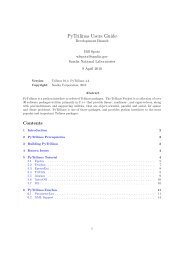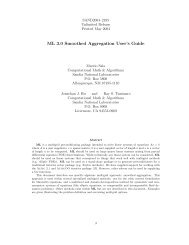nonsymmetric dynamics
ML 5.0 Smoothed Aggregation User's Guide - Trilinos - Sandia ...
ML 5.0 Smoothed Aggregation User's Guide - Trilinos - Sandia ...
- No tags were found...
You also want an ePaper? Increase the reach of your titles
YUMPU automatically turns print PDFs into web optimized ePapers that Google loves.
Cholesky factorization) as a smoother within the multigrid method. Using Krylov smoothers<br />
as a preconditioner could potentially be more robust than using the simpler schemes provided<br />
directly by ML. However, one must be careful when multigrid is a preconditioner to<br />
an outer Krylov iteration. Embedding an inner Krylov method within a preconditioner to<br />
an outer Krylov method may not converge due to the fact that the preconditioner can no<br />
longer be represented by a simple matrix. Finally, it is possible to pass user-defined smoothing<br />
functions into ML via ML Set Smoother. The signature of the user defined smoother<br />
function is<br />
int user_smoothing(ML_Smoother *smoother, int x_length, double x[],<br />
int rhs_length, double rhs[])<br />
where smoother is an internal ML object, x is a vector (of length x length) that corresponds<br />
to the initial guess on input and is the improved solution estimate on output, and rhs<br />
is the right hand side vector of length rhs length. The function ML Get MySmootherData(smoother)<br />
can be used to get a pointer back to the user’s data (i.e. the data pointer given with the<br />
ML Set Smoother invocation). A simple (and suboptimal) damped Jacobi smoother for the<br />
finest grid of our example is given below:<br />
int user_smoothing(ML_Smoother *smoother, int x_length, double x[], int rhs_length, double rhs[])<br />
{<br />
int i;<br />
double ap[5], omega = .5; /* temp vector and damping factor */<br />
Poisson_matvec(ML_Get_MySmootherData(smoother), x_length, x, rhs_length, ap);<br />
for (i = 0; i < x_length; i++) x[i] = x[i] + omega*(rhs[i] - ap[i])/2.;<br />
}<br />
return 0;<br />
A more complete smoothing example that operates on all multigrid levels is given in the file<br />
mlguide.c. This routine uses the functions ML Operator Apply, ML Operator Get Diag, and<br />
ML Get Amatrix to access coarse grid matrices constructed during the algebraic multigrid<br />
process. By writing these user-defined smoothers, it is possible to tailor smoothers to a particular<br />
application or to use methods provided by other packages. In fact, the Aztec methods<br />
within ML have been implemented by writing wrappers to existing Aztec functions<br />
and passing them into ML via ML Set Smoother.<br />
At the present time there are only a few supported general parameters that may be<br />
altered by users. However, we expect that this list will grow in the future. When using<br />
ML Iterate, the convergence tolerance (ML Set Tolerance) and the frequency with which<br />
residual information is output (ML Set ResidualOutputFrequency) can both be set. Additionally,<br />
the level of diagnostic output from either ML Iterate or ML Solve MGV can be set<br />
via ML Set OutputLevel. The maximum number of multigrid levels can be set via ML Create<br />
or ML Set MaxLevels. Otherwise, ML continues coarsening until the coarsest grid is less<br />
than or equal to a specified size (by default 10 degrees of freedom). This size can be set via<br />
ML Aggregate Set MaxCoarseSize.<br />
52







